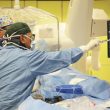Courtesy of Dr. Carlos Fava. Primary coronary angioplasty has been the treatment of choice for acute myocardial infarction (MI) for many years, but such strategy is associated with nonculprit lesions in a large group of patients. While it has been proven that nonculprit-lesion revascularization offers better outcomes, the groups that would benefit from it are...
The Real Impact of Peripheral Artery Disease in TAVR
Courtesy of Dr. Carlos Fava. The real incidence of peripheral artery (PAD) disease in TAVR remains unclear. Different reports still estimate it is between 10 and 46%, but they have shown it has a negative impact in evolution. 51,685 TAVR patients were analyzed. 12,740 of these patients presented PAD (24.6%). PAD patients tended to be...
Supervised Exercise and Revascularization for Intermittent Claudication
The combination of optimal medical treatment plus angioplasty plus supervised exercise seems to be the first line of treatment for patients with intermittent claudication, in terms of maximum walking distance and best quality of life. This combination requires a multidisciplinary team for the best possible results. The aim of this study was to conduct a...
Improved Outcomes after Lower Limb Revascularization
Operator ability combined with improved and diverse devices for lower limb revascularization has clearly increased in the last decade. However, is this technical feasibility we did not use to have translating into better clinical outcomes for patients, or is it simply inflating our interventionist egos? This study aims at answering the question above by identifying...
What Happens When We Are Blinded by Left Main Disease and Ignore All Other Lesions?
According to this recent Excel analysis, mortality seems to rise when the SYNTAX II score is not taken into account when defining the revascularization strategy. The difference does not reach statistical significance and further studies are required, but the message is clear: the left main coronary artery is not the only thing that matters; other...
EXCEL Outcomes: PCI vs CABG in Patients with Prior Cerebrovascular disease
Most certainly, as we read this title, we imagine the conclusion (as does the editor): patients with prior cerebrovascular disease (CEVD) benefit from a less invasive revascularization strategy, such as PCI. However, the EXCEL outcomes tell us that patients with left main coronary artery disease (LMCAD) and a history of CEVD will not benefit from...
DES and DCB with Similar Results in Femoropopliteal Artery Disease
Courtesy of Dr. Carlos Fava. Nowadays, peripheral interventions are on the rise and the technological development of stents and balloons would help achieve better outcomes. Both drug-eluting stents (DES) and drug-coated balloons (DCB) have proved to be beneficial for femoropopliteal interventions, but the actual role of each of these technologies remains unclear. This prospective, randomized 1:1...
FDA Alert on Drug-Coated Balloons and Stents in Femoropopliteal Artery Disease
The US Food and Drug Administration (FDA) has issued an alert on the potential long-term risk of paclitaxel-coated balloons and paclitaxel-eluting stents in patients with femoropopliteal artery disease. This agency is evaluating signals of increased long-term deaths among patients with femoral or popliteal artery disease treated with paclitaxel-coated devices in a recent study. In...
Infrainguinal Bypass Following Failed Endovascular Intervention Has a Different Outcome
We often inform our patients we should first approach the superficial femoral with an endovascular intervention, and that should it fail or develop restenosis, we could always resort to a bypass. We were not lying when we’d assume a bypass following endovascular intervention would have the same outcome as a primary bypass. Simply put, no...
Exercise Programs in Peripheral Artery Disease
Programmed exercises are recommended as initial management strategy for patients with peripheral artery disease (PAD). Most exercise programs include supervised treadmill walking twice or three times a week in a strategic facility (such as a gym). PAD patients often give up on these programs seeing as they might find it difficult to keep to a...









